The art of Kenbu, steeped in the spirit of the samurai, is a theatrical display of grace and discipline. It is here, amidst the fluid dance and poised swordplay, that costuming becomes a narrative in itself, weaving history, functionality, and tradition into the very fabric of the performance.
A Stitch in Time: The Fabric of Samurai Legacy
Kenbu attire, known as 'Shozoku', echoes the bygone era of the samurai while serving the practical needs of modern performers. It consists of several key components: the 'Hakama', 'Keikogi', and, on formal occasions, the 'Haori'. The Hakama, with its wide-legged design, offers the freedom necessary for sweeping gestures, while its pleats are more than mere ornamentation—they symbolize the enduring virtues of the samurai ethos.
The choice of material for these garments is deliberate. Natural fibers such as cotton and silk are selected for their comfort and flexibility, vital for the rigorous movements of Kenbu. These fabrics often feature traditional patterns or family mons (crests), connecting the practitioner to the broader narrative of their heritage.
The Palette of Performance: Color and Symbolism
In Kenbu, the costume's color is a silent storyteller. Black and indigo dominate, reflecting the solemnity of the art. However, the spectrum may vary to align with the performance's narrative, with each hue adding a symbolic depth. The red of passion, the white of purity, each color is a thread in the tapestry of the story being told.
The Ensemble: Accoutrements with Purpose
Integral to the Kenbu costume is the 'Obi', a belt that secures the Hakama and provides a sheath for the sword—a physical and symbolic burden for the Kenbu practitioner. Complementing the Obi is the 'Sensu', or folding fan, an accessory that punctuates the air with each controlled motion, becoming a focal point of expression within the dancer's hands.
Dressing the Part: A Ritual of Preparation
The act of donning the Kenbu costume is a ritual, a prelude to the performance. It is an exercise in mindfulness, each fold and tie a step in the mental preparation for the dance to come. The dressing process is as much a part of Kenbu as the physical practice, setting the stage for the transformation from the ordinary to the extraordinary.
Unchanging Threads: The Timelessness of Kenbu Costumes
In the contemporary practice of Kenbu, costumes have retained their traditional essence. This fidelity to tradition affirms the practitioners' connection to the past. For them, the Shozoku is more than mere attire—it is an embodiment of the samurai legacy, a manifestation of their martial identity.
The Dance of Fabric and Steel
As Kenbu practitioners take to their stage, their costumes do more than serve the aesthetic demands of the performance. They carry the weight of history, the pride of lineage, and the responsibility of tradition. In the seamless interplay of fabric and steel, Kenbu costumes are not just worn; they are experienced, bridging centuries and bringing the past alive with every step and stroke.




